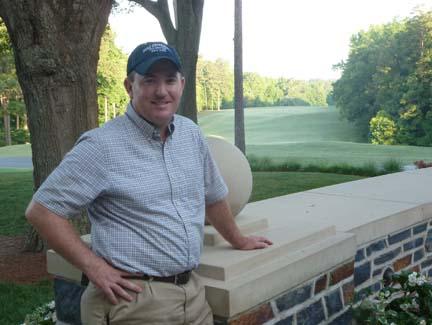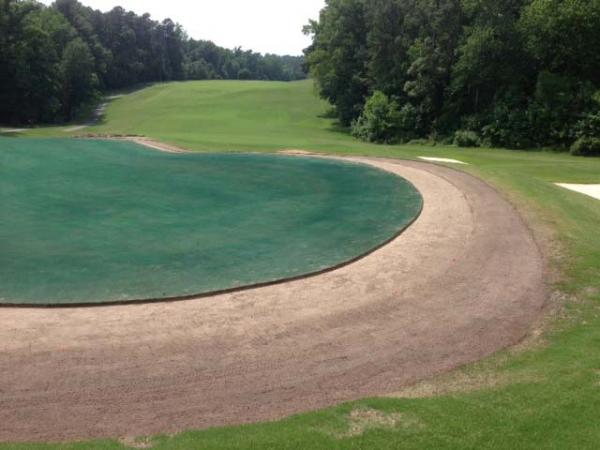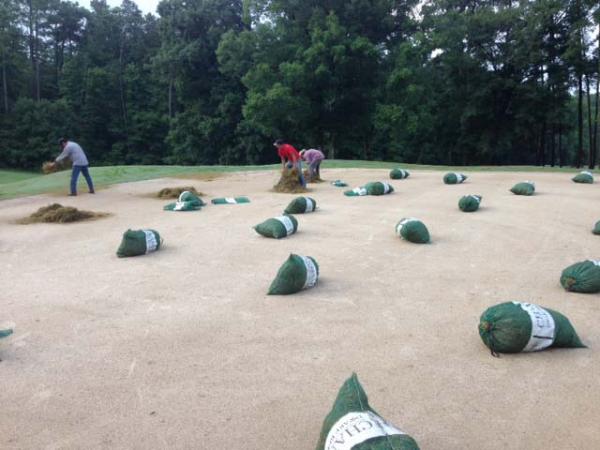 When the time came for a greens restoration at Duke University Golf Club, there were plenty of reasons to shun tradition and regrass the putting surfaces with warm-season turf, but superintendent Billy Weeks and general manager Ed Ibarguen couldn't come up with any good reasons not to.
When the time came for a greens restoration at Duke University Golf Club, there were plenty of reasons to shun tradition and regrass the putting surfaces with warm-season turf, but superintendent Billy Weeks and general manager Ed Ibarguen couldn't come up with any good reasons not to."I had been researching this change for over 10 years. I was fully committed to making the change," said Ibarguen. "My only difficulty was convincing those with a stake in the golf course at the university that ultradwarf Bermuda was better than bentgrass for our location in North Carolina. That process delayed the conversion by several years."
By the time the decision finally was made to regrass the course in Durham, North Carolina with Bermuda in 2013, the university had hired superintendent Billy Weeks, who despite his age, already was an old hand at managing Bermuda.
A graduate of Mississippi State University, Weeks had spent most of his career on warm-season grass in Mississippi, Alabama, Florida, Georgia and Texas until taking the job at Duke three years ago.
The former superintendent at Steelwood Country Club in Loxley, Alabama, Weeks prepped under Eric Bauer, then at The Club at Carlton Woods near Houston, managed a putting green at Jack Nicklaus' home in North Palm Beach, Florida and interned at places like Augusta National Golf Club.
Prior to the 2013 restoration, Duke Golf Club last was renovated in the mid 1990s when the greens were seeded with Penncross. Weeks found evidence that they'd since been interseeded with L-93, A-1, A-4, G-2 and Crenshaw.
Carved out of the edge of the Duke Forest, which covers more than 7,000 acres, the course is heavily lined with trees, and since the idea of using fans to promote air movement conflicts with the university's sustainability efforts, coupled with the area's historically hot summers, it wasn't long before those Heinz 57 greens began to show signs of weakness.
Some greens had become as much as 80 percent Poa annua.
"Bentgrass in the correct climate is a wonderful playing surface," Ibarguen said. "Golf courses in cooler climates have greatly benefited from improved varieties of bentgrass. However, if you have a golf course in a location that has prolonged heat during the summer months, it is insane not to convert to an ultradwarf Bermudagrass.
"There are too many (benefits) to count. The critical ones for us are related to bottom line revenue and player satisfaction."
By the time Weeks was hired at Duke three years ago, Poa had encroached on just about every putting green on the course.
"Bermudagrass was a great way to improve the course and adhere to what the university wanted to do," Weeks said.
 Weeks explored all options, and looked at ultradwarf varieties from TifEagle to MiniVerde. He decided on Champion. Although Weeks doesn't consider himself a follower of the herd, several other courses throughout central North Carolina already were managing Champion, and he liked the idea of having a ready-made support network.
Weeks explored all options, and looked at ultradwarf varieties from TifEagle to MiniVerde. He decided on Champion. Although Weeks doesn't consider himself a follower of the herd, several other courses throughout central North Carolina already were managing Champion, and he liked the idea of having a ready-made support network."All the ultradwarfs are good grasses, but Champion had the characteristics I was looking for here at Duke," he said. "Ed and I test drove all the ultradwarfs and ultimately Champion was the grass I recommended to the University."
The final choice came down to Champion and one other popular ultradwarf - MiniVerde.
"Deciding between the grasses took some research as well," Ibarguen said. "We met with both several grass suppliers, visited and/or played multiple golf courses that had already installed the grass. All the ultradwarfs are excellent grasses, but ultimately we decided that Champion would be the best fit for the Duke University Golf Club."
Seemingly like many universities, there are construction projects galore taking place at Duke, some of which include upgrades to athletic facilities. Specifically at Duke, current projects include a renovation of the Wallace Wade Stadium and construction of a new track and field complex. Because of the strain of so many projects running concurrently, the golf course restoration was completed using the no-till method.
With the help of architect Rees Jones, the plan was to reclaim as much of the original green contouring as possible. Weeks said he and Jones went over each detail of every green three times before the project started.
About 25,000 square feet was reclaimed throughout the course, however, the No. 7 green presented a problem. The presence of a greenside bunker and slope severity prevented reclaiming lost space there because doing so would have eliminated space needed to turn greensmowers, Weeks said.
The project also included plans to selectively remove trees around the green complexes to allow for sunlight and air movement on the new greens, and that required getting the approval from officials who manage the Duke Forest.
The forest covers 7,000 acres spanning three counties and has been a research and educational tool for the university since 1931.
Weeks used a mobile app called Sun Seeker that allowed him to create a presentation showing before-and-after effects of shade on specific areas in question. Once Jud Edeburn, special projects manager for the forest, granted his stamp of approval in short order once visited the course and saw the plan firsthand and learned how it fit in with the university's overall conservancy ideals. Removing the trees occurred during the winters of 2011 and 2012.
 The no-till method included sprigging the greens at a rate of 35 bushels per 1,000 square feet, or about 40-50 bags of sprigs per green, Weeks said. A heavy regimen of topdressing, often at rates of up to 200 pounds per 1,000 square feet, watering and feeding had the greens ready for mowing about a month after sprigging despite what turned out to be a cool summer in 2013.
The no-till method included sprigging the greens at a rate of 35 bushels per 1,000 square feet, or about 40-50 bags of sprigs per green, Weeks said. A heavy regimen of topdressing, often at rates of up to 200 pounds per 1,000 square feet, watering and feeding had the greens ready for mowing about a month after sprigging despite what turned out to be a cool summer in 2013."Every two to three days something was going out on those greens," Weeks said. "We pretty much followed Mike Brown's recommendation from Champion Turf Farms for our grow-in program. They have perfected this process I didn't see any reason to reinvent the wheel.
"The summer was rough. We were in the 90s only five or six times with 26 inches of rain from the day we closed June 1 to the day we reopened September 1. We were still ready in 90 days."
After about 11 months of play, greens are rolling at 12 on the Stimpmeter and the reviews have been overwhelmingly positive.
"The new putting surfaces provide our players with championship quality putting greens on a daily basis throughout the year," Ibarguen said. "We have never been able to say that while we had bentgrass greens because the summertime playing conditions were abysmal. Elevated mowing heights, never finding a balance between too dry and too wet, ball marks were abundant, the greens always on the verge of disease and the playing speeds were far too slow for an enjoyable round of golf.
"Our superintendent, Billy Weeks, has found the perfect blend of creating a smooth and firm surface yet, hold good shots perfectly."

